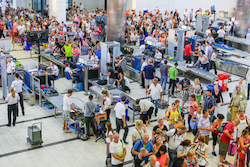New sensor innovations aim to tackle drug smuggling
Drug trafficking is big business, bringing in a fifth of all profits from organised crime. Illicit operations frequently involve multiple states, and often overlap with offences such as financial crime and cybercrime. Law enforcement agencies and customs officials play a critical role in stopping drugs from entering and circulating in Europe. A lack of easy-to-use, effective detection tools at their disposal however can make it difficult for them to tackle this form of crime.
Using electrochemical sensors to find drugs
The EU-funded BorderSens(opens in new window) project investigated the potential of using electrochemical sensors to find drugs in different situations. These were conceived of and trialled in collaboration with end users such as port officials and police services. The starting point was ports, where authorities have to monitor and sometimes investigate containers. This can take time. “When authorities find a suspicious compound, what they need is a quick and easy way of testing,” explains BorderSens project member Annemarijn Steijlen from the University of Antwerp(opens in new window) in Belgium. “At the moment, tests are not that reliable and sometimes subjective – they cannot always be used as proof of drug discovery.” Authorities also sometimes need more detailed information on possible illicit substances. Raman spectroscopy(opens in new window) – a chemical analysis technique that provides detailed information about the chemical structure – is accurate but expensive. The project team therefore looked at developing a handheld device that could deliver accurate results for an array of possible substances, quickly. The project team also worked with police forces. They often need to test people for small amounts of drugs, to determine whether they are using or carrying. Here, user-friendliness and access to rapid results are critical.
Handheld easy-to-use devices
After understanding these end-user needs, the project team developed a range of three prototype electrochemical detectors, which were trialled at ports and by police forces across Europe. A key aim was to make these handheld devices easy to use and quick, and for the results to be fully understandable to non-chemists. The technology is cloud-based, but the devices can also work offline. This is an important consideration given that container ports sometimes do not have good wireless connections. “The first product is a simple handheld single sensor, which can be used to determine whether a powder is cocaine or not,” adds Steijlen. “The user dissolves the powder in a solution, puts the droplet on the electrode and gets a read-out in less than a minute.” The project team also developed the BorderSens array, a more ambitious system that can detect a range of drugs at once. In a similar way to the single sensor, users deposit the solution on an electrode, but this time, six tests can be run simultaneously. A third prototype was developed specifically for the police, and can be used to detect small amounts of drugs from saliva. The system is tuned to be ultrasensitive to specific molecules.
Meeting end-user needs
The successful trial of these three prototypes has helped to further advance electrochemical sensor technology in the field of drug detection. The goal now is to refine the technology further, and eventually bring these tools to market. “One of the challenges has been that end-user needs are very different,” says Steijlen. “This is why we developed different solutions.”







